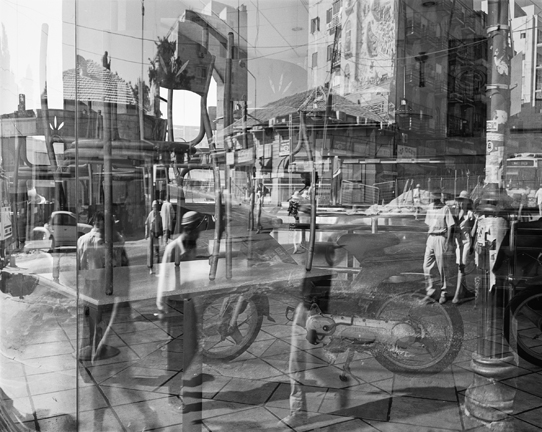Yoav Horesh, Sbarro Pizzeria, Jerusalem, August 2003, gelatin silver print, 18½ x 14¾”. Courtesy of the artist.
Horesh was a student in Boston during 9/11 and was struck by how different the American response, with its grounded planes and makeshift memorials, was from his own experiences in Israel. While the American impulse was to “never forget,” Israel’s urge was to erase. (Though curator Kristina Durocher sees a parallel between “America’s response to mass shootings as a new societal norm” and the “cultural fatalism” in Horesh’s photos.)The ghostly reflections in a Sbarro window gesture at what can’t be seen. There are no monuments here, as Horesh explains, because there would be a plaque on every corner. If Lee Friedlander’s The American Monument is a testament to monuments hiding in plain sight, Horesh’s Aftermath, also a book, is a mournful dirge for trauma swept under the rug in the name of “normalcy.”By evoking the uncomfortable gap between violence and the collective “cleanup,” Horesh leaves us space to contemplate. Who was the bomber? Who were the victims? What butterfly effect has been set in motion?
The work I am influenced by and analysing is from his project ‘Aftermath’ It nods to the traditions of street photography, photojournalism and the archival impulse, as well as photo books like Joel Sternfeld’s On This Site and The American Monument. Yet unlike Friedlander, Horesh can only capture the hum of ghosts. To paraphrase Robert Frank, Horesh’s compassionate eye listens before it looks. Yoav Horesh B/W and colour photographs have been dealing with conflict, human tragedy, memory and recovery in Europe, Asia and America since 2001. His deep interest in the history of “sites” led him to explore close and far locations in search for cultural clues and personal histories. His evolving practice has grown from “street photography” to large format landscapes, interiors and portraits that open up the discussion between present and history. His projects also took place in the American South-west, Germany, Laos, Israel, the Gaza Strip and Cambodia, where history still shapes and influences current events and life.

ANYLSIS: I chose to study Horesh, as a consequence from this image. I believe not only does this image show an encounter of our daily lives, but it is a perfect example of chaos. The many images being overlaid. creates a composition that is not messy, but almost works structurally as a whole. The element within each image fit s together and creates a new composition. Each image slipping into a different aspect creating interests of architecture, and new movements of present and past people. This is clearly a very organised and thought out image, and one he did not easily put together. This also symbolises a passing of time, it shows the impact of live, perhaps the evolution of the area, due to the consequences of events which occurred there.
The concept from this image was from a book called aftermath. it is a presentation to make a political point about the conditions and daily lives that are similar to many in poverty and living in this area. His work is a transgression of more complex pieces such as the one above, and also images of slow shutter speed watching the visibility of cars moving, people, and details and shadows and aspects usually unseen in an area. He not only successfully captures the attitudes of people so well, but he too demonstrates knowledge of how to show these emotions very personal to an individual through a piece from a location. he himself has said ‘For two and a half years I photographed over 100 different sites of the suicide bombings in Israel while I lived in New York. I would go to photograph at least twice a year while doing my research for official and non-official information I needed in the United States. The bombings were happening on a daily basis; I would turn on the computer or read the newspapers and obviously I was very worried about my family and friends. The thought that they could be taking a bus or walking down the streets and disappear from life within a blink of a second horrified me. Perhaps it was also the feeling of guilt that pushed me to start this project, to be in far New York while this was happening in Israel so frequently. Maybe this is my mechanism of dealing with trauma; Repeating the action, the visitation, photographing, like going back to “a crime scene” and trying to understand what has happened there psychologically and visually.’
why did I choose this artist: He not only successfully captures a narrative of chaos caused by suicide bombings, and a clear emotional responses to each and everyone of his photos, but also his ranges from teaching 4×5, colour, black and white, darkroom printing techniques to digital photography. His subject matter has always remained the same: life, family, our history and primary emotional responses to the world. Ut’s about how we interpret the world using photography and how we analyse and understand photographs in various contexts. I don’t think these things changed since the first camera was manufactured, only the tools changed. It used to be large format box camera and now you have your phone camera. His photography is not just about creating impressive imagery, but I think that with this project, he was also trying to raise awareness about how life is made a series of random events that affects all of us tremendously. These places he photographed were mundane. They were dictated because of their traumatic history. There was nothing unique about these sites until history scarred them. They turned into significant sites of trauma that he reduced into pictures of the landscape, the city, trees, cafes or street corners.
